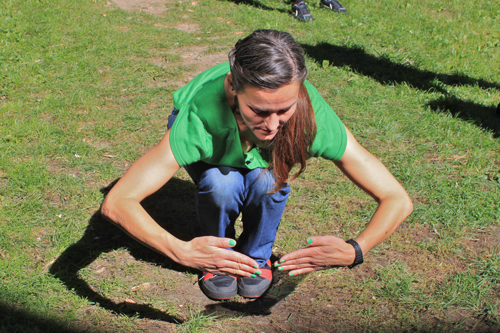
A bold new conference at McGill showcases the growing movement of research creation
By Victoria Leenders-Cheng
Quick – multiple choice question.
What does one do at an academic conference devoted to exploring ideas of time?
a) Bust some moves at a lunch-hour dance party
b) Attend a talk by a Pulitzer-winning composer as one of his works is performed on solo violin
c) Discuss a paper on accelerationist politics with 20 people…one at a time, speed-dating style
If that academic conference is Time Forms, held Sept. 18-21 at McGill, then the answer is:
d) All of the above – and more
“We realized we did not want to give a standard conference where people come and read papers – not that there is anything wrong with that – but we wanted to find new ways of presenting research results,” said McGill Philosophy professor Eric Lewis, who co-organized the conference with two McGill colleagues, Alanna Thain (English) and Stephen McAdams (Music).
Time Forms placed strong emphasis on research creation, or the practice of combining creative and academic approaches to research, and boasted a roster of well-respected academics, including Roger Reynolds, a Pulitzer-winning composer and professor at the University of California San Diego and Oxford University professor of Music and Anthropology Georgina Born.
The idea of research creation was on full display during a walking tour led by Dutch dance troupe Vloeistof, where students and conference participants donned MP3 players then followed dancers through the streets of Montreal while listening to a pre-recorded narrative soundtrack.
“Weeds are a good indicator of tolerance in a neighborhood,” a woman’s voice said as the group set off from the corner of Milton and Durocher streets, on the first of five tours held during the conference.
Dancer Sarah Manya chose this moment to climb the fence of a brownstone on Durocher Street.
“I’m looking for a tender aspect in this street,” the voice continued, as Manya wandered down an alley bookended by piles of trash and began to sway back and forth in front of a grimy basement window.
“By most traditional standards, a public dance performance in the street is not considered a ‘publication,’” added Schulich School of Music professor Stephen McAdams, smiling. “But we wanted to make the process part of the final product instead of creating something and then writing a paper about it.”
There is solid theory behind the ideas of research creation, said Vloeistof choreographer and dancer Anja Reinhardt. A performance such as Manya’s, which attracted the attention, amusement and incredulity of neighbourhood residents and passers-by, challenges notions of time as an objective concept and encourages participants to reflect on the connections between walking, thinking and time.
“The process of putting a dance or theatre experience in a public space puts the public in a very active role where they begin to ask questions about what is theatre,” she said. “It is a different way to frame reality.”
Research creation also entails thinking differently about the academic experience, including traditional seminar-style discussions. Instead of gathering around a table and taking turns discussing an assigned text entitled The Acceleration Manifesto, about 20 people engaged in a lively dissection of the text in a Concept Speed Dating session that rotated discussion partners every five minutes.
“This is a concept I’ve brought to my classrooms as well,” said Alanna Thain, professor of English and the third co-organizer of the conference. “The format of the discussion means that by the time you switch partners a few times, the traces of previous conversations will enter into the present discussion.”
Lewis and McAdams both noted that research creation is a way of bringing the university into the community. A dance party organized by LunchBeat Montreal, the fourth of an ongoing series of lunch hour dance events, brought more than a hundred of people to the Multi Media Room in the basement of the Schulich New Music building.
“Universities are occasionally not very welcoming places for the public,” said Lewis. But with local DJ Mark Vicente at the helm of LunchBeat and the Multi Media Room featuring installations by renowned artist John Heward, “this was a way of bringing people into our university and building bridges with the community.”
